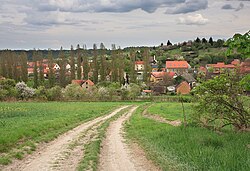Bílichov is a municipality and village in Kladno District in the Central Bohemian Region of the Czech Republic. It has about 200 inhabitants.
Bílichov | |
|---|---|
 General view | |
| Coordinates: 50°15′44″N 13°54′59″E / 50.26222°N 13.91639°E | |
| Country | |
| Region | Central Bohemian |
| District | Kladno |
| First mentioned | 1407 |
| Area | |
| • Total | 12.21 km2 (4.71 sq mi) |
| Elevation | 365 m (1,198 ft) |
| Population (2024-01-01)[1] | |
| • Total | 214 |
| • Density | 18/km2 (45/sq mi) |
| Time zone | UTC+1 (CET) |
| • Summer (DST) | UTC+2 (CEST) |
| Postal code | 273 74 |
| Website | www |
Etymology
The initial name of the settlement was Bílechov. The name was derived from the personal name Bílech, meaning "Bílech's (court)". Since 1600 at the latest, the current name has been used.[2]
Geography
Bílichov is located about 18 kilometres (11 mi) northwest of Kladno and 37 km (23 mi) northwest of Prague. It lies mostly in the Džbán range, only a small eastern part of the municipal territory extends into the Lower Ohře Table. The highest point is at 453 m (1,486 ft) above sea level. The stream Zlonický potok (here also called Bílichovský potok) originates in the municipality and supplies a set of small fishponds.
There are four small-scale protected areas in the municipality: national nature monuments Bílichovské údolí and Cikánský dolík, and nature monuments Smradovna and Na Pilavě.
History
The first written mention of Bílichov is from 1407, when it was part of the Žerotín estate.[3]
Demographics
|
|
| ||||||||||||||||||||||||||||||||||||||||||||||||||||||
| Source: Censuses[4][5] | ||||||||||||||||||||||||||||||||||||||||||||||||||||||||
Transport
There are no railways or major roads passing through the municipality.
Sights
The main landmark of Bílichov is the Chapel of Saint Wenceslaus. It was built at the end of the 19th century.[6]
References
External links



